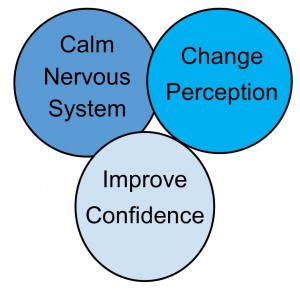The 3 Essential Keys to Ending Anxiety
by Charles Beeson
Ending anxiety can be challenging. Overcoming mild, moderate and severe anxiety symptoms can be relatively quick and easy. But, unless the method that is used includes 3 essential ingredients, the results can often be disappointing.
These 3 Keys to Ending Anxiety are:

The fearful feeling, we call anxiety, is normal and necessary for every human being.
It helps to keep you safe when confronted with a dangerous threat. When your mind perceives you’re in a situation that requires a quick and forceful response, it triggers the brain to release adrenaline and cortisol into the blood stream.
This reaction, commonly called the “fight or flight” response, causes an increased heart and breathing rate to provide you with extra strength and speed. You need this ability to keep safe. Anxiety can also remind us of the consequences of our actions to help motivate correct behavior.
But, if you’re experiencing anxiety and there is no “REAL” danger or threat, it can destroy your happiness and quality of life. According to the National Institute of Mental Health, over 40 million adults in North America, experience this unwanted anxiety.
The expert authorities cite that it is highly treatable. The internet is saturated with cures and treatments for ending anxiety. But, if you’re ready to do something to end your suffering… you need to make sure the solution provides everything that alleviates all or most of your symptoms
These 3 ingredients need to address the different ways anxiety symptoms are presented. They apply to EVERY type of anxiety disorder. These symptom categories are: cognitive, emotional, behavioral and physical.
Here are some examples of these anxiety symptoms:
Cognitive (Thought Process) Symptoms
- Unable to concentrate.
- Becoming easily confused.
- Having memory problems.
- Thinking about negative things all the time.
- Negative self-talk.
Emotional Symptoms
- Feeling angry, frustrated, irritable
- Feeling sad or depressed
- Feeling fearful, guilty
- Feeling restless
Behavioral Symptoms
- Sleeping difficulties. Sufferers of stress often find it difficult to switch off. …
- Lack of punctuality
- Absenteeism
- Withdrawal
- Exhaustion
- Addictive/excessive behavior. …
- Unhealthy eating habits. …
- Risk-taking behavior.
Physical Symptoms
- Low energy
- Headaches
- Upset stomach, including diarrhea, constipation and nausea
- Aches, pains, and tense muscles
- Chest pain and rapid heartbeat
- Insomnia
- Frequent colds and infections
- Loss of sexual desire and/or ability
- Nervousness and shaking, ringing in the ear
- Cold or sweaty hands and feet
- Excess sweating
- Clenched jaw and grinding teeth
The symptoms listed above are often associated with severe stress and Generalized Anxiety Disorder (GAD).
The “Physical Symptoms” listed above are created from this protective process and are usually noticed by: rapid breathing at the top of the chest, making it difficult to breath and, a pounding heart. This can result in what we call an anxiety attack… which can escalate into a panic attack.
Every normal person on the planet, usually, experiences this during their lifetime. Significant, stressful life events can make a person more vulnerable, as well as, genetic factors that are passed down in families. This can cause a greater sensitivity to these fearful feelings.
When this behavior begins repeating itself, it can become a terrifying HABIT. So, it’s vital to move forward and make these 3 key objectives a priority. I provided a checklist for each one, based on my 27 years of experience in coaching my clients
Key #1: Calm Your Nervous System
By relaxing the mind and body you can reconnect to the brain’s relaxation response. This connection is through the “parasympathetic nervous system’… and, the stress response is then stopped! The brain switches over and away from the fear response that’s being activated through the sympathetic nervous system.
Key #2: Change the Mind’s Perception
The thoughts of the anxiety sufferer must be modified to end the THREAT PERCEPTION, if there is no actual danger. This is a process of re-learning (cognitive re-structuring).
Key #3: Improve Self-Confidence
In order to stop the ongoing fear of the possibility of the reoccurrence of an anxiety or panic attack… a person must feel confident in themselves and their anxiety management techniques.
InstaCalm® Anxiety Treatment Protocol Addresses All 3 Critical Steps to Ending Anxiety
The InstaCalm Anxiety Treatment Program was designed to help a person achieve these objectives in just a few weeks. Anxiety sufferers NOT living in the San Jose, California Area, should consider a comprehensive, ONLINE program on www.AnxietyBeGone.com . It provides access to online self-help courses that follow this treatment.





